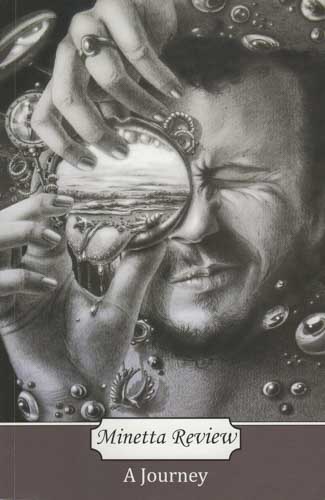Minetta Review – Fall 2013
According to its inviting website, Minetta Review is “a student-run publication at New York University [which also considers] writing and artwork from all over the country, and . . . [has] even published international submissions.” It’s the oldest literary publication at NYU; this is the publication’s fortieth anniversary. According to its inviting website, Minetta Review is “a student-run publication at New York University [which also considers] writing and artwork from all over the country, and . . . [has] even published international submissions.” It’s the oldest literary publication at NYU; this is the publication’s fortieth anniversary.
The website provides an appealing verbal image of NYU students gathering every Thursday afternoon from submittal deadline to publication, arguing the merits of offerings of poetry and prose under 1500 words and, when those selections are made, pooling from among art submissions to find highly complementary visuals. Certainly that’s one strong way to read this issue—as a unified network of visual and verbal art. Such a network is well exemplified by Kid Useless’s “Spiders Do Know the Answer, Of This I Am Certain (2012).” In this lovely photograph, the white threads of an imperfect spiderweb shimmer around the spindly arachnid in the center—just as, in this issue, threads of themes connect prose, poetry, and artwork to frame a fragilely unified whole.
The issue is evenly divided among poetry, prose, and color art plates. Among the best of the latter are Kristen Reichert’s photographs, experimental renderings of pretty young women whose hair, clothes, and surprised facial features meld with neon swirls of color. Ian Tiseo’s “Chum Salmon Run!,” an appealing primitive/cartoon illustration of a lively bear, and Emily DuFrirsz’s “Robot in Bed with Bunny Slippers”—possibly a pencil sketch—also set a high standard. A number of other well-reproduced photographs, drawings, and pastels please the eye (such as Divya Adusumilli’s deep blue “Sunsets”) and challenge the intellect (such as Tracy A. Marciano’s flickering red “Hallway to Questionable Judgment”) or even clutch at the heart. “Through” by Sarah Calico and “Pierced” by Sarah Doody both represent imaginative juxtapositions. The photographer’s gaze through fence slats, and the stoic’s lust for bodily adornment, need no words in these attention-catching works of art.
But we can still use words, certainly. Kate Belew’s poem “God Tree,” with its images of medicine wheels, fossils, and salt pillars, speaks not only with particular specificity to Kid Useless’s upward-spiraling photograph appropriately titled “The Radial Symmetry of Trees (2013),” but also to all three of Diana Bauza’s haunting “Las Lomas de Lachay” photographs, whose background air seems faintly polluted, yet meditative and ancient. Likewise, Mark A. M. Tamura’s fantasy game-type graphic titled “The last of its kind—amphibian dragon” and the surreal “Guggenheim Museum” by Matt Held on the facing page, both echo the spirit of Abraham Elms’s “Borges and I,” a short-short send-up of the master labyrinther himself:
I was sitting on the edge of my bed early one morning, weary from a night of disturbing dreams, when I noticed a book of Borges’s poetry sprawled open at my feet. I picked it up and began to read, but when I reached the end of the first line I was unable to go any further. I went back to the beginning of the line and read it once more, enchanted by the arrangement of its words. I read it again and again, wanting each time to go beyond it but ineluctably dragged back to its beginning. I dare not write the line here, for I’m afraid that if I did I would be unable to write anything else.
As in Borges’s own work, and also in the Tamura and Held images, what’s inside the frame and what’s outside it spiral around upon themselves, calling upon the reader/viewer’s powers of deduction to decipher the unexpected paradoxes in encounters with non-ordinary reality.
The poem “A sincere attempt at explanation of the paradoxical feelings of Kid Useless” can’t help but reverberate with such art. But it also recalls, of course, the author’s own photographs. Similarly, the poems about particular artists recall those artists—and more. Although Lyn Lifshin’s poems on Georgia O’Keefe refer to no actual O’Keefe-like artwork in the journal, Lifshin’s lines “bones and moons / bones and flowers / a reddish bone with a yellow sky” certainly resonate with Allyson Block’s multicolored abstract oil “Faces” as well as with Jihan Kikhia’s almost stained-glass apparition, “Syria.” Interestingly, though Ricky Garni’s poem “Feet” evokes Frieda Kahlo by name, it also calls out to a short story in the journal: the narrator in Caroline Bruckner’s short story, “Entirely Without Regret” has the same angst about shoes as Garni’s Kahlo.
As a last note, a wonderful set of “archival” pieces completes this issue. A brief prose excerpt from Thoreau tugs at our literary pride; three gorgeous Aubrey Beardsley artworks remind us whence our love for retro comes; Stradanus’s “Odysseus in the Cave of the Winds” is stunning even in 4×6 black and white; and Winsor McCay’s graphic story “Dream of Rarebit Fiend” and an excerpt from Yeats’s Celtic Twilight bring us into quite different realms of the early twentieth century.
This issue of Minetta Review is subtitled “A Journey.” Possibly the most compelling journey of all is the journey of themes and images echoed between and among the well-chosen individual works presented here. It’s a journey worth taking.
[minettareview.wordpress.com]





